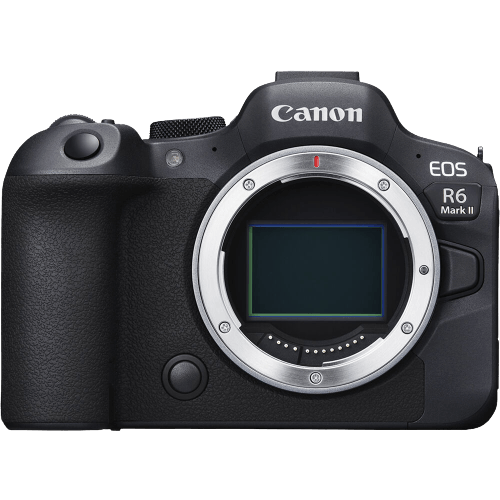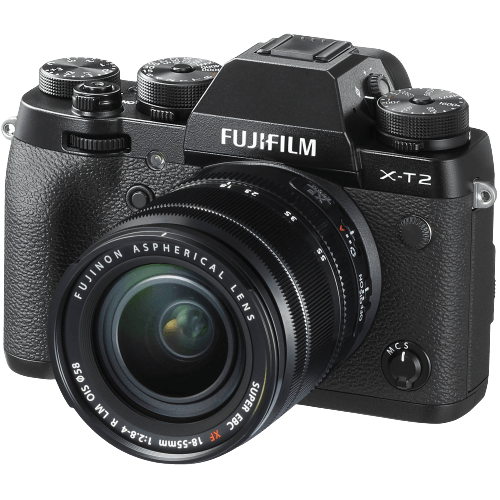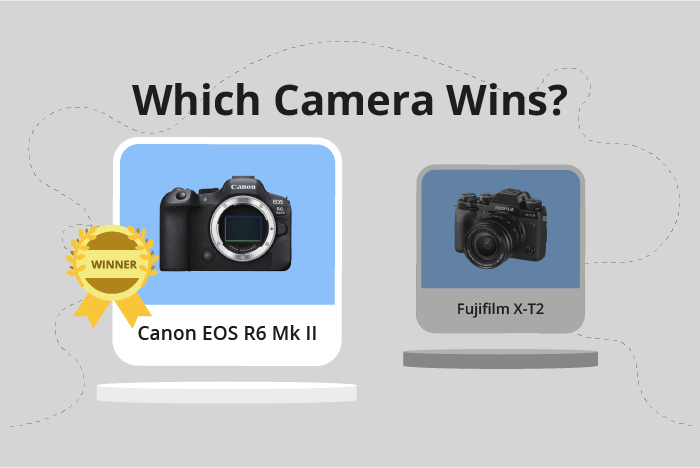Canon EOS R6 Mark II vs Fujifilm X-T2 Comparison
Canon EOS R6 Mark II

Fujifilm X-T2

The Canon EOS R6 Mark II outperforms the Fujifilm X-T2 with a score of 78/100 compared to 68/100. Both cameras are mirrorless and share some similarities in size and weight, with the Canon measuring 138.4 × 98.4 × 88.4mm and weighing 588g, while the Fujifilm is slightly smaller and lighter at 133 x 92 x 49mm and 507g.
The Canon EOS R6 Mark II, released in 2022, has several advantages including its higher score, more advanced features, and better overall performance. Its launch price is $2499, reflecting its premium capabilities.
On the other hand, the Fujifilm X-T2, released in 2016, offers a more affordable option with a launch price of $1599. Its smaller size and lighter weight could be an advantage for some users seeking portability.
Considering these factors, the Canon EOS R6 Mark II is the superior camera, while the Fujifilm X-T2 remains a viable choice for those on a tighter budget or prioritizing compactness.
Canon EOS R6 Mark II vs Fujifilm X-T2 Overview and Optics
The Canon EOS R6 Mark II emerges as the winner in optics with a score of 83/100, while the Fujifilm X-T2 scores 66/100, a difference of 17 points. Both cameras share some common specifications, such as 24-megapixel CMOS sensors, making them capable of capturing high-quality images.
The Canon EOS R6 Mark II outperforms the Fujifilm X-T2 in several areas. Its full-frame sensor size allows for better low-light performance and increased dynamic range compared to the Fujifilm’s APS-C sensor. The Canon also has a faster shooting speed of 40 frames per second, compared to the Fujifilm’s 14 frames per second. This makes the Canon more suitable for capturing fast-moving subjects or action shots. Additionally, the Canon EOS R6 Mark II features image stabilization, which helps reduce camera shake and improve image sharpness. The camera also has a higher DXOMARK sensor score of 91, indicating better overall image quality.
The Fujifilm X-T2, however, has its own advantages. Its X-Processor Pro provides faster image processing and better color reproduction than the Canon’s Digic X processor. The Fujifilm X-T2 also has a more diverse lens selection due to its Fujifilm X lens mount, allowing for greater flexibility in shooting styles and focal lengths.
Taking these factors into account, the Canon EOS R6 Mark II is the superior option for photographers seeking better low-light performance, faster shooting speeds, and image stabilization. However, the Fujifilm X-T2 may be a better choice for photographers who prioritize lens selection and color reproduction. Each camera has its strengths, and the choice ultimately depends on the specific needs and preferences of the photographer.
Canon EOS R6 Mark II vs Fujifilm X-T2 Video Performance
The Canon EOS R6 Mark II and the Fujifilm X-T2 both have a video score of 83/100, indicating that their video capabilities are on par with each other. They share several common specifications, such as 4K max video resolution, 3840 x 2160 max video dimensions, 60fps max video frame rate, and built-in time-lapse functionality.
The Canon EOS R6 Mark II excels in its autofocus capabilities, offering a more advanced and accurate system compared to the Fujifilm X-T2. This results in smoother and more precise focus transitions during video recording, which is essential for professional videography.
On the other hand, the Fujifilm X-T2 has a slight advantage in terms of color reproduction and film simulation modes. This allows users to achieve a more cinematic look without the need for extensive post-processing. The X-T2 also offers a more compact and lightweight design, making it easier to carry around and use in various shooting situations.
Taking these factors into account, it is clear that both cameras are strong competitors in terms of video capabilities. The Canon EOS R6 Mark II stands out for its superior autofocus system, while the Fujifilm X-T2 offers better color reproduction and a more portable design. Ultimately, the choice between these two cameras will depend on the specific needs and preferences of the user.
Canon EOS R6 Mark II vs Fujifilm X-T2 Features and Benefits
The Canon EOS R6 Mark II wins the feature comparison with a score of 72/100, while the Fujifilm X-T2 scores 70/100. Both cameras share some common specifications, including a 3-inch screen size, flip screens, WIFI, and Bluetooth capabilities.
The Canon EOS R6 Mark II outperforms the Fujifilm X-T2 in two key areas: screen resolution and GPS functionality. The Canon’s screen resolution is 1,620,000 dots, significantly higher than the Fujifilm’s 1,040,000 dots. This means the Canon offers a clearer, more detailed display for reviewing images and navigating menus. Additionally, the Canon EOS R6 Mark II has GPS functionality, allowing users to geotag their photos with location data, a feature not available in the Fujifilm X-T2.
The Fujifilm X-T2, however, has one advantage over the Canon EOS R6 Mark II: a lower price point. This may appeal to budget-conscious photographers who are willing to compromise on certain features.
To sum up, the Canon EOS R6 Mark II stands out with its higher screen resolution and GPS functionality, making it the better option for photographers seeking top-notch image review and location data capabilities. On the other hand, the Fujifilm X-T2 offers a more affordable option for those willing to forgo certain features. Both cameras provide essential features like flip screens, WIFI, and Bluetooth, ensuring that users can enjoy a quality shooting experience with either choice.
Canon EOS R6 Mark II vs Fujifilm X-T2 Storage and Battery
The Canon EOS R6 Mark II and Fujifilm X-T2 both have a storage and battery score of 68/100. They share common specifications, such as two memory card slots and compatibility with SD, SDHC, and SDXC (UHS-II) memory cards. Both cameras also support USB charging.
The Canon EOS R6 Mark II has a slightly better battery life of 360 shots, compared to the Fujifilm X-T2’s 340 shots. The R6 Mark II uses the LP-E6NH battery type, while the X-T2 uses the NP-W126S battery type. This difference in battery life gives the R6 Mark II an advantage for extended shooting sessions.
The Fujifilm X-T2 does not have any significant advantages in storage and battery over the Canon EOS R6 Mark II. Both cameras perform similarly in this category, with only minor differences in battery life.
Considering the storage and battery aspects, the Canon EOS R6 Mark II and Fujifilm X-T2 are quite similar. The R6 Mark II has a slight edge in battery life, but overall, both cameras provide adequate performance in terms of storage and battery capabilities.
Alternatives to the Canon EOS R6 Mark II and Fujifilm X-T2
Are you still undecided about which camera is right for you? Have a look at these popular comparisons that feature the Canon EOS R6 Mark II or the Fujifilm X-T2:

